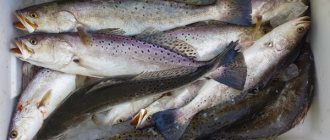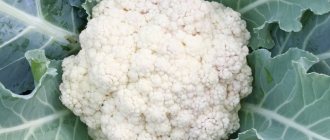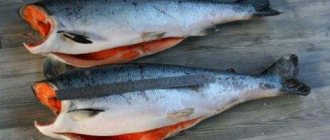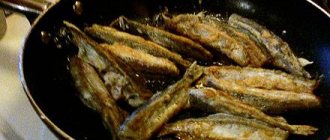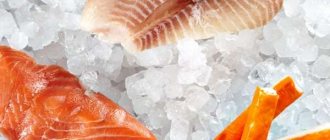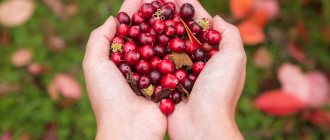Calorie content of trout
The calorie content of the product is 88 kcal.
The method of preparation affects the calorie content of the product: smoked fish has 132 kcal, salted fish - 198.6 kcal, canned fish - 162 kcal. The carbohydrate content is minimal, no more than 1 g. There is a lot of protein in trout - more than 20 g. Raw fat - 2 g. When cooked, the amount of fat increases. When cooking, changes in the properties and composition of products occur, and trout also undergoes transformations when heated and salted. Below is detailed information about changes in nutritional value, KBJU in individual dishes.
The benefits of trout
Trout has a very good effect on brain activity, increases performance, reduces fatigue, improves memory and attention. This product is able to protect against the development of atherosclerosis, reduces nervousness and anxiety, fights stress, and has a preventive effect against the development of cancer.
Eating this fish helps the body get rid of waste and toxins, correct blood pressure, and improve the general condition of diabetes and psoriasis. What makes trout a very popular product is its hypoallergenic nature. The special amount of KBJU makes this fish simply irreplaceable for people who are being treated for obesity or simply want to keep their body weight under control.
There is very little harm from trout, but several breeds of fish sometimes contain mercury, which can be dangerous for pregnant and breastfeeding women, so it is not advisable for them to eat a lot of it.
People who experience heavy physical activity may become deficient in energy and nutritional value due to the low calorie content of trout. Therefore, they need to combine this product with side dishes that are high in carbohydrates and calories and keep track of the BJU. And it’s best to bake or fry fish.
Trout contains a large number of useful substances, including vitamins (A, D, B12, E), fatty acids (Omega-3, Omega-6), amino acids (mainly aspartic, glutamic), micro-, macroelements. Rich mineral composition. Eating trout has a beneficial effect on the body as a whole: brain function improves, cholesterol levels decrease, and nerves and blood vessels are strengthened.
Recipe? Recipe!
What can be cooked from this fish? Yes, a lot of things! Here's a simple recipe for you:
Trout with sour cream:
We offer our readers the following recipe for preparing this fish. The dish turns out surprisingly tender and really tasty.
Products needed for cooking:
- Trout (fillet)
- Sour cream - 3 cups
- Garlic - 1 clove
- Parsley
- Black pepper (to taste)
Preparation:
The fish fillet is cut into large pieces (in the shape of flat squares) 8-10 cm in size. Then the fish should be salted and peppered to taste. The garlic is finely chopped, the herbs are chopped - after which it is all mixed with sour cream and salted.
Place the cooked pieces of fish in a preheated frying pan with oil. Each piece should first be fried on one side for 5 - 7 minutes, then carefully turn it over and, using a spoon, place the prepared mixture of herbs, garlic and sour cream on the fried side. Then the fish is fried for about 5 - 7 minutes. The fish is decorated and the dish can be served. It is served still hot. And enjoy this dish.
For a diet aimed at helping a person lose weight, it is important to select products that are not only low in calories, but also as healthy as possible. With a modest energy value, they should ideally have a whole storehouse of microelements and vitamins to make the menu complete and nutritious. A real godsend for the diet is trout. Despite the fact that the calorie content of any type of trout will please even the most picky people, the amount of useful elements in it is amazing. If you cook this fish without adding a large amount of fat and spices, it will be difficult to find a more dietary dish with low calorie content. And the range of recipes from this universal product includes not only hot dishes, but also salads.
You could write a whole treatise on the benefits of eating trout, but here is just one fact that will convince many. This river or sea fish is very capricious, and it can only survive in clean waters. In turbid water with elevated temperatures, trout quickly die. Therefore, the consumer can be calm about the quality of the meat of this fish. Although you still cannot do without precautions, and the choice of trout also needs to be approached with the utmost seriousness.
Fresh trout
A raw carcass has from 95 to 110 kcal per 100 grams of weight. Like any animal product, there are no carbohydrates in it, but there is 19 g of protein and 2.3 g of fat. The composition of the chemical elements of the fresh product is rich and consists of the following components:
- vitamins A and K (fat soluble);
- the whole range of B vitamins;
- trace elements including Ca, Mg, Cu and Zn;
- essential fats such as omega-3 and omega-6;
- unsaturated acids: linoleic, linolenic, palmitoleic and arachidonic.
The nutritional value
The calorie content of raw trout is about 96–100 kcal per 100 grams of product. It contains 19 grams of protein and 2.2 grams of fat, and no carbohydrates at all. The chemical composition of trout is diverse. It contains the following elements:
- fat-soluble vitamins (vitamin A, K);
- B vitamins (B1, B6, B12);
- minerals (Ca, Mg, Cu, Zn);
- fatty acids (omega-3, omega-6);
- unsaturated fats (linoleic, linolenic, palmitoleic, arachidonic).
All these substances are necessary for the proper and harmonious functioning of our body. Scientists have long proven that modern people need to eat fish at least 2 times a week. Members of the salmon family are some of the best options for meeting your vitamin, mineral and essential fatty acid needs.
What are the benefits and how can trout be harmful?
Some types of trout contain mercury, a heavy metal that is dangerous to the human body. Fish may contain parasites. The product is fatty, so it is not recommended for people with gastrointestinal diseases, liver diseases and ulcers.
| Product | Kcal | Proteins, g | Fats, g | Angle, g |
| Trout, all types, raw | 148 | 20,77 | 6,61 | |
| Trout, all types, cooked in the heat | 190 | 26,63 | 8,47 | |
| Rainbow trout, farmed, raw | 138 | 20,87 | 5,4 | |
| Rainbow trout, farmed, cooked in the heat | 169 | 24,27 | 7,2 | |
| Rainbow trout, wild, raw | 119 | 20,48 | 3,46 | |
| Rainbow trout, wild, cooked in the heat | 150 | 22,92 | 5,82 | |
| Rainbow trout fish | 119 | 20,48 | 3,46 | 0 |
| Marinated trout | 136,48 | 20,02 | 6,15 | 0 |
| Canned trout | 162 | 18 | 10 | 0 |
| Smoked trout | 132 | 26 | 3,1 | 0,5 |
| Salted trout | 198,6 | 16,8 | 14,6 | 0 |
| Trout fish | 88 | 17,5 | 2 | 0 |
| Trout Lightly salted | 264 | 37,04 | 11,79 | 0 |
| Baked or Fried Trout | 188 | 24,37 | 9,16 | 0,41 |
| Wild Rainbow Trout | 119 | 20,48 | 3,46 | 0 |
| Rainbow Trout (Farmed) | 138 | 20,87 | 5,4 | 0 |
Contraindications and harm
Contraindications for consumption and harm to trout for health are primarily related to the ability of seafood products to accumulate heavy metals such as mercury. This element, even in the smallest quantities, is harmful to the body, so it is not recommended to overuse fish. A sufficient frequency of trout consumption is up to 3 meals per week.
In addition, you should avoid red fish:
- if there is an individual intolerance to the product or an allergic reaction;
- during lactation and pregnancy, women should refrain from eating trout, especially salted, as salt retains fluid in the body and aggravates the swelling already present during pregnancy;
- You should not eat raw fish - the product may be affected by parasites, so heat treatment is required;
- If you have diseases of the liver or gastrointestinal tract, eating red fish is contraindicated;
- eating salted or fried trout is contraindicated in case of cardiac ischemia, hypertension or atherosclerosis;
- to lose weight, you need to give up salted trout, as it retains fluid in the body;
- Salty foods should be avoided if you have kidney disease, since salt in the body will increase the amount of fluid consumed, which will lead to additional stress on the organ.
It is important to know: some varieties of fish are capable of accumulating mercury in greater quantities than others, but in order not to remember all varieties, it is enough to remember the general rule: the larger the fish, the higher the content of heavy metals in the meat. Brook trout is one of the fish species that accumulates mercury in lower quantities.
Lightly salted trout
Lightly salted fish has 186 kcal per 100 grams of weight. Its chemical composition contains elements as a percentage of the daily human consumption:
- vitamin B2 - 11.1% of daily intake;
- choline - 13%;
- vitamin B5 - 38.8%;
- vitamin B12 - 259.7%;
- vitamin D - 39%;
- vitamin E - 16.7%;
- vitamin PP - 50%;
- magnesium - 15%;
- phosphorus - 30.4%;
- iron - 13.9%;
- manganese - 42.6%;
- copper - 18.8%;
- selenium - 22.9%;
- chromium - 110%.
It’s easy to prepare lightly salted trout even at home:
- first of all, clean the fish carcass, and then separate the meat from the bones and backbone and rinse the fillet under running cold water;
- then we prepare a salty mixture of salt and sugar in proportions 2: 1. For a medium-sized fish, four tablespoons of salt and half as much sugar are required; pour as much of the pickling mixture into the prepared bowl as needed, place the trout fillet on it and sprinkle on top and sides;
- after 5-6 hours, turn the fish over and leave for the same amount of time; At the end of salting, remove the fish, rinse with cold water to remove any remaining salt and dry with napkins or paper towels.
Harm to the body from rainbow trout
Scientists have not identified any harmful effects of rainbow trout on the human body when consumed. However, people with allergic reactions to fish should avoid eating trout, as well as any other fish.
Consume only fresh rainbow trout meat in normal quantities - in this case, its consumption will not cause any harm to the body.
- The largest trout species is the lake trout, found in the Great Lakes (USA), Alaska and Canada. This type of trout can reach a weight of 45 kilograms.
- Rainbow trout are capable of spawning at 3 years of age and typically breed every 3-5 years.
- Rainbow trout are considered endangered in some regions of the United States.
- If rainbow trout migrate to the ocean as adults rather than remain in streams and rivers, they are called steelhead trout. Her body is almost entirely silver in color.
- The average lifespan of rainbow trout is 4 to 6 years in the wild.
- The spawning season for rainbow trout is spring.
- Rainbow trout are farmed on all continents except Antarctica.
- The color of rainbow trout meat will vary depending on the fish's diet and environmental conditions.
- Man began breeding rainbow trout in 1870. The largest producer of trout is Chile.
- During the spawning season, one trout can spawn anywhere from 200 to 8,000 eggs.
- Rainbow trout are an indicator of water pollution because they can only survive in clean waters.
- This fish spawns in the waters where it was born.
Trout is a high quality fish; it lives only in clean waters, and therefore is considered extremely clean and healthy. During diets, it is recommended to eat lean fish - it is high in protein and low in calories. And trout - is it a dietary fish? How many calories are in trout and is it possible to eat trout during a diet?
Trout, like all fish, does not contain carbohydrates. Its composition is 17.5% proteins, but it contains only 2% fats. Water makes up 70% of a trout's weight.
Due to its low fat content and calorie content, trout is quite low. The calorie content of trout is only 88 kcal per 100 grams. There are also fatty varieties of trout - due to the high fat content (7 times more!), the calorie content of trout of such varieties can be about 230 kcal per 100 grams.
The calorie content of trout baked in foil with lemon is 182 kcal per 100 grams - such a high calorie content of trout in its finished form is explained by the fact that during the baking process, the liquid in the fish meat comes out, so the dry mass increases by the same volume. The calorie content of lightly salted trout is 186 kcal per 100 g and higher (it all depends on the oil content in such trout, for example, the calorie content of lightly salted trout “Russian Sea” is 224 kcal per 100 g, because it is prepared with some vegetable oil. There are brands and more fatty lightly salted trout - information about the fat content and calorie content of trout can always be found on the packaging. Calorie content of boiled trout - 108 kcal per 100 g. Calorie content of trout caviar - 246 kcal per 100 g.
This low calorie content of trout allows it to be used to prepare healthy low-calorie dietary dishes that can become a valuable source of protein during your diet.
Grilled trout
- Trout carcass 1 piece
- Spices, salt and pepper to taste
Calories:213 kcal
Proteins:21 g
Fat:6 g
Carbohydrates:0 g
clean the carcass and rinse under running water
Cut the prepared carcass into steaks, pour freshly squeezed juice of one lemon on all sides and rub with a mixture of salt and ground black pepper. Leave to marinate for 20-30 minutes at room temperature;
then place the fish steaks on the grill grate and, turning as needed, fry as long as necessary until fully cooked and a crispy crust appears. Place on plates and add boiled side dish.
Steamed trout
This steamed dietary dish is tastier than boiled fish and trout will have 125 calories per 100 grams of weight, which also contains 17 grams of protein and 6 grams of fat. To prepare it you need:
- clean the trout, divide into medium-sized pieces so that one is enough for a serving;
- Rub the prepared trout pieces with salt, pepper and spices and leave to marinate;
- add a liter of water to a double boiler or saucepan and bring to a boil;
- place portions of fish in a steamer bowl or on a special steaming stand in a saucepan;
- after 15–22 minutes, turn the pieces over and wait the same time until fully cooked;
- At the end of the process, place on plates and add a side dish, also cooked in a double boiler, boiled vegetables or salad.
Baked trout
This is a fragrant recipe and here the trout has a calorie content per 100 grams of weight of 170 kcal and also contains 22 grams of protein and 9 grams of fat. To bake a product you need to do the following:
- clean the trout, wash it, dry it and cut it into steaks, two cm thick or a little more;
- Sprinkle each portion of fish with lemon juice and salt, rub with a mixture of pepper and fish spices. Leave to marinate for half an hour;
- Grease a special dish (you can use foil) for the oven with vegetable fat and place portioned pieces of fish in it. If you want, you can put vegetables on top (onions, peppers, eggplant, etc.);
- First, preheat the oven to 180C, place the dishes with fish in it and cook for up to 40–50 minutes.
This dish can be eaten cold or hot. In general, there are a lot of ways to cook fish in foil.
Beneficial features
Regular consumption of lightly salted trout reduces the risk of developing atherosclerosis, stabilizes the nervous system, and improves brain function. Trout meat has the ability to lower cholesterol, strengthen the heart muscle, normalize blood pressure and improve memory. In addition, being a hypoallergenic product, it is approved for use by people suffering from psoriasis, diabetes and allergies. Vitamin E in the product improves the condition of the skin.
Fried trout
In this cooking method, fried fish absorbs some of the oil, due to which the fat content of the finished dish becomes greater. Therefore, the calorie content will already be 215 kcal per 100 grams of weight, and the protein content will be 19 g and fat 14 g. To prepare fried trout, this is the recipe:
- Clean the trout, rinse and dry. If the carcass is small, then it can even be fried whole; large fish should be cut into pieces;
- then marinate the fish for about an hour, pouring lemon juice on it and rubbing it with a mixture of salt and seasonings;
- heat the frying pan and pour a small amount of vegetable oil onto it; Dip fish pieces in flour on all sides and place in a frying pan;
- cook until golden brown, turning the pieces as needed; Cool portions and place on plates with a boiled side dish or salad. Fish can be eaten cold or hot.
Spicy salads with trout
Vegetable snack dishes with the addition of trout are low in calories and have a pleasant taste. For example, you can cook this fish with broccoli. For this you will need these products.
Low calorie salad recipe
First of all, wash all the products and dry them with a paper towel. Place the broccoli in a small saucepan and place on the heat for literally five to seven minutes. This cabbage has a very delicate texture, so it is important that the vegetable is not overcooked. After the required time, remove the broccoli from the water and cool. Cut the fish into thin slices, place on a wide dish and add salt. Microwave for fifteen minutes. When the fish is ready, try to remove all the bones from it, and divide the fish pieces into small ones that will be convenient to take with a fork. When serving, place the fish on the bottom of the plate and place a layer of broccoli on top. Season with olive or other vegetable oil and, if desired, sprinkle with finely chopped herbs - the dish is ready.
An even simpler low-calorie salad recipe requires the following ingredients:
- any salad mix - 1 package;
- fish fillet - 400 g;
- fresh cucumbers - 3 pcs.;
- Tabasco pepper sauce - to taste;
- natural yogurt - 100 ml;
- lemon - 1 pc.;
- salt - to taste.
Boil the trout fillet in water with a little salt. Then cool and cut into small cubes. Peel two cucumbers and cut into slices. Turn another cucumber into a puree in a blender. Add yogurt, a quarter teaspoon of Tabasco sauce, the juice of half a lemon, and a little salt to this puree. Whisk all the ingredients in a blender - this will be a salad dressing. Place the greens from the salad mixture, cucumbers and trout on a wide platter. Pour dressing on top and mix all ingredients.
Trout is called the “royal fish”, and for good reason: it can be fried, salted, boiled, baked, steamed and grilled, and even eaten raw in sushi; one thing remains unchanged - its surprisingly delicate taste. However, few people know that trout is not a separate species of fish; moreover, such a species, strictly speaking, does not exist at all. This is the name of the special, “residential” form of several species of fish from the salmon family. The fact is that the fish species that gave rise to trout are classified as “anadromous”: i.e. They spend most of their lives in the open sea, but lay eggs in rivers and streams. As they grow up, most of the fry leave the river “kindergarten”, but some may remain there for the rest of their lives. It is those fish that do not leave the spawning grounds of their parents that are called river trout. Lake trout, apparently, appeared from those young salmon that, instead of the open sea, ended up in lakes and remained there, giving rise to a new population. There is also sea trout; it lives in coastal waters and does not go into the ocean.
Chemical elements in trout and their effect on the human body
Trout is beneficial not only because of its low calorie content, but also because it contains a lot of necessary and irreplaceable elements. The following have a beneficial effect on people's health:
- vitamin PP - corrects blood glucose levels, reduces bad cholesterol and therefore is a good method of therapy and prevention for high blood glucose, helps the heart and blood vessels function better, takes part in many chemical processes in the human body, therefore reducing the risk of diseases hearts;
- phosphorus - improves brain activity;
- chlorine - takes part in maintaining water balance and metabolism, in the secretion of gastric juice;
- sulfur - stimulates the growth of nails and hair and improves the skin;
- iron - simply vital for normal hemoglobin levels;
- zinc - increases immunity levels and helps brain function and memory;
- copper - promotes healthy skin and hair;
- selenium - removes free radicals from the body, inhibits the withering of the body, thanks to which the health and beauty of the body is maintained longer, and also inhibits the occurrence of malignant formations;
- manganese - strengthens the cardiovascular and nervous systems, participates in the production of hormones and improves immunity;
- iodine - vital for the functioning of the thyroid gland;
- chromium - promotes the elimination of fats and regulates insulin levels;
- fluoride - makes teeth strong;
- molybdenum - regulates blood glucose, destroys carcinogens, takes part in the processes of metabolism and synthesis of substances;
- Nickel - is part of cell DNA and increases metabolism; vitamins A and E are antioxidants;
- B vitamins - protect against stress and depression, help brain activity, regulate metabolism, strengthen the immune system and the condition of the skin, nails and hair;
- vitamin D - without which it is impossible to maintain healthy bones, cartilage and nerves; Omega-3 acid - preserves youth, prevents cancer, heals the heart and blood vessels, helps the human reproductive organs function well.
Application
A variety of canapés and sandwiches with lightly salted trout can make even the most modest table look royal. Becoming a frequent guest on your menu, lightly salted trout will ensure health for many years.
Market Analytics
- COVID-19 is changing the rules of the game in the cosmetics market
- Beauty of the future: cosmetic innovations 2020
- New ingredients are the driving force of the cosmetics industry
Convenient search for beauty salons on our website
Beauty salons in Moscow Beauty salons in St. Petersburg Beauty salons in Ekaterinburg Beauty salons in Novosibirsk
Latest blog posts on our website
- Naturecream / Geranium (Pelargonium) oil for skin health and beauty
- Prostye-sovety / Save on a beauty salon: procedures that can be done at home
- Naturecream / Growth Factor - brings back youth?
- Oksana-Lezina / 3 effective abdominal exercises from a fitness instructor for beginners
- Prostye-sovety / Making perfect curls at home
- Prostye-sovety / Which hair removal method to choose
- Naturecream / Wrinkles Puppets
- Naturecream / PEPHA-TIGHT - instant skin lifting
- Naturecream / Blue light - a danger to the skin
- Naturecream / Cocoa Butter – A treat for the skin
Latest forum topics on our website
- Mrs._Smith / Badly sunburned! What to do?((
- Ice / Is it necessary to combine fitness classes with a diet?
- Antonova / What can be used for hair loss?
- Radio operatorKat / Who was on a protein diet?
- Suzanna / Mesotherapy on the face
Other articles in this section
| Toothfish This large fish belongs to the nototheniaceae family. There are two types of these fish - Patagonian fangs and Antarctic fangs. Patagonian toothfish can be seen in some markets in Moscow, where it is called Chilean sea bass. |
| White Sea navaga One of the subspecies of the Far Eastern navaga is the White Sea navaga. As a rule, its main habitat is the White Sea, but it can also be found in the waters of other northern or eastern seas. This species has an elongated shape and a fairly large size. A distinctive feature of the White Sea navaga from its relatives is the larger number of vertebrae. The best time to catch White Sea navaga is late autumn or winter. Fish caught during this period has the brightest and most persistent taste. |
| Horse mackerel in oil Horse mackerel is a small sea fish belonging to the order Perciformes. Lives in warm waters near continents. The horse mackerel's body is oblong, slightly pressed laterally. The main difference is the bony scutes on the sides, located from the head to the tail. |
| Striped catfish The common or striped catfish lives off the coast of the Kingdom of Norway, Greenland, the Atlantic coast of North America, the northern islands of Scotland and the Faroe Islands. Distributed in the western part of the Baltic Sea. It reaches a length of up to 125 cm and weighs up to 21 kg. Due to the decline in numbers, individuals are caught mainly for scientific purposes. |
| Stuffed river perch Perch is the most common type of fish that lives in almost any body of water. Perch meat is characterized by excellent taste and nutritional composition. Perch is very easy to prepare in any form. One common method is to prepare stuffed perch. This way the dish acquires a brighter flavor and increases its beneficial properties for the body; moreover, this is the most successful option for preparing fish for the holiday table. |
| Boiled trepang Trepang, or sea ginseng, is a marine invertebrate animal belonging to the echinoderm species. They live naturally in Southeast Asia. In appearance it resembles a large worm with many papillae (small soft outgrowths) growing on its back. Sea cucumbers have a mouth opening surrounded by 20 tentacles that help capture food. An adult specimen grows up to 40 cm in length. The weight of sea cucumber can reach 1.5 m. |
| Sterlet A fish like sterlet leads an active lifestyle all year round. These fish do not swim alone, and it is extremely rare to see a lone sterlet. Sterlet belongs to the sturgeon family, but it does not make transitions. The fish move from the beginning of spring to the end of autumn, but not far. In winter, the sterlet lives in one place. This fish lives only in fresh water. |
| Crab meat Crabs are arthropods belonging to the class of crustaceans. They have five pairs of legs. The first pair of legs evolved into claws. Crabs live in all seas of the planet. Depending on its habitat, the colors of the crab can be varied. For example, crabs living in the depths of reservoirs have a brown, greenish color. Crabs that live on land are sandy in color. |
| Fresh capelin Capelin belongs to the smelt fish family. There have been cases in history when fishermen caught too much fish from the Berents Sea. This had a very bad effect on the reproduction of capelin, and on the lives of those fish and birds that fed on this fish. Currently, there is a restriction on catching this fish, and the number of capelin is gradually increasing. |
| Navaga Navaga is a sea fish belonging to the cod family. Inhabits cold bottom waters of coastal areas of Primorye. Commercial fishing is carried out in the waters of the Chukchi, Okhotsk, Japan and Bering seas, mainly in the winter season. Cod fry grow quite quickly and by two years reach 25-30 cm in length and weigh about 1.6 kg. |

